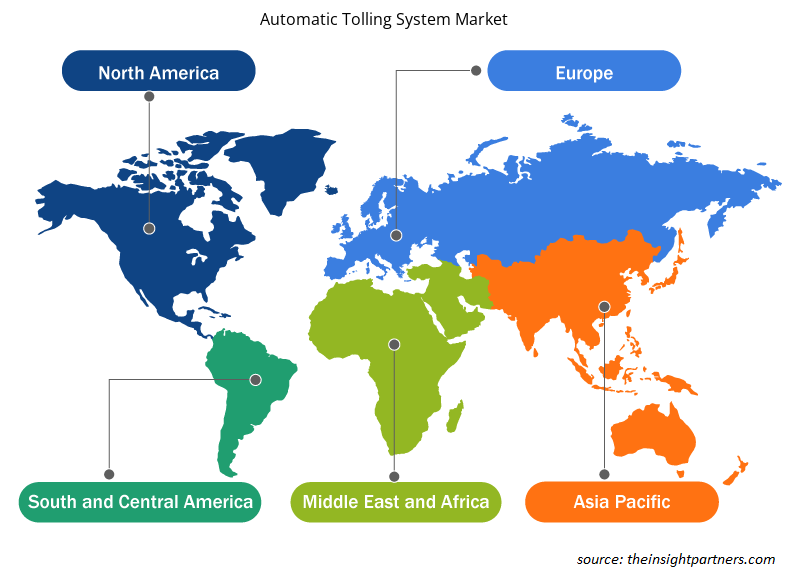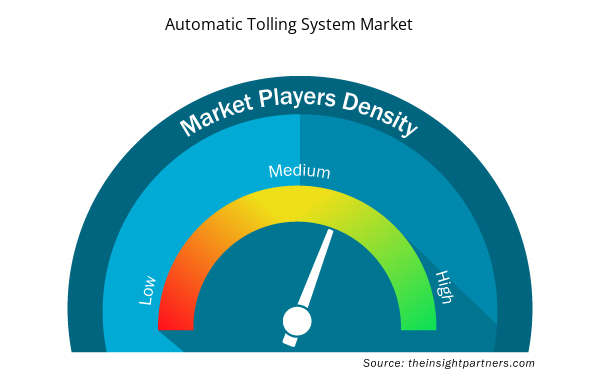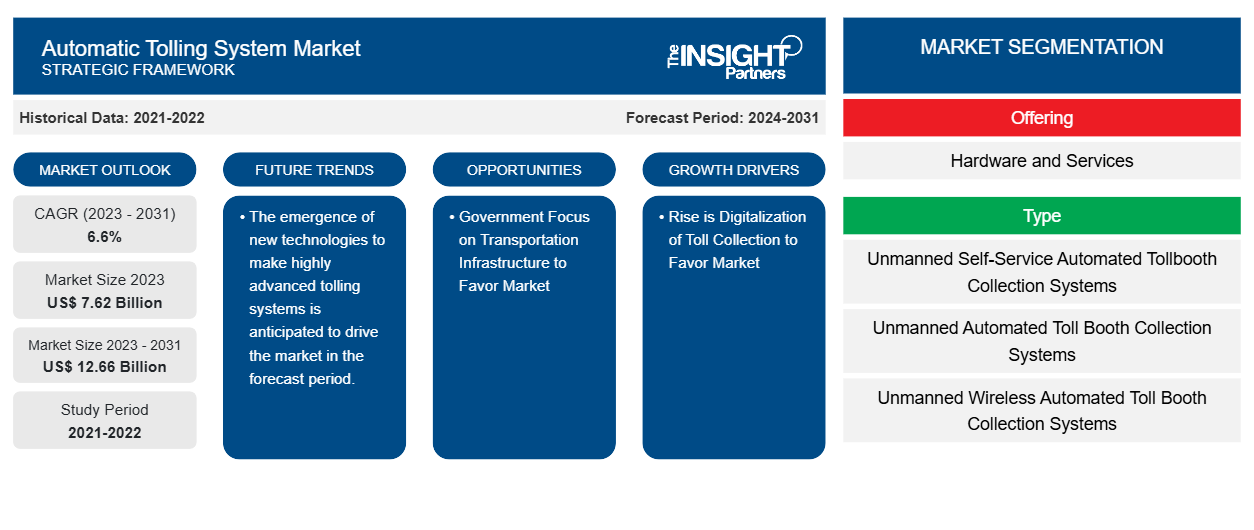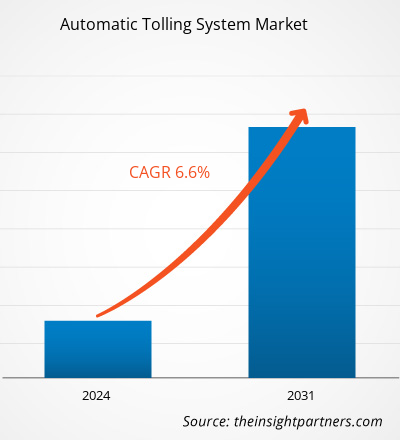Der Markt für automatische Mautsysteme soll von 7,62 Milliarden US-Dollar im Jahr 2023 auf 12,66 Milliarden US-Dollar im Jahr 2031 anwachsen. Der Markt wird zwischen 2023 und 2031 voraussichtlich eine durchschnittliche jährliche Wachstumsrate von 6,6 % verzeichnen. Die zunehmende Digitalisierung der Mauterhebung sowie langfristige wirtschaftliche und sicherheitsrelevante Vorteile dürften die wichtigsten Treiber und Trends des Marktes sein.
Marktanalyse für automatische Mautsysteme
Der Markt für automatische Mautsysteme verzeichnet weltweit ein starkes Wachstum. Dieses Wachstum ist auf Faktoren wie die zunehmende Digitalisierung der Mauterhebung sowie langfristige wirtschaftliche und sicherheitsrelevante Vorteile zurückzuführen. Darüber hinaus wird erwartet, dass die steigende Nachfrage nach effektiven Mautmanagementsystemen in Schwellenländern und die Entstehung neuer Technologien zur Herstellung hochmoderner Mautsysteme den Markt in den kommenden Jahren ankurbeln werden.
Marktübersicht für automatische Mautsysteme
Elektronische Mautsysteme (ETC) erheben Mautgebühren, ohne dass der Fahrer etwas unternehmen oder anhalten muss. Das System belastet die Konten der registrierten Autobesitzer oder erkennt das Nummernschild für eine spätere Abrechnung, ohne dass die Fahrzeuge anhalten müssen. ETC-Spuren verbessern die Geschwindigkeit und Effizienz des Verkehrsflusses und sparen dem Fahrer Zeit.
Passen Sie diesen Bericht Ihren Anforderungen an
Sie erhalten kostenlos individuelle Anpassungen an jedem Bericht, einschließlich Teilen dieses Berichts oder einer Analyse auf Länderebene, eines Excel-Datenpakets sowie tolle Angebote und Rabatte für Start-ups und Universitäten.
- Holen Sie sich die wichtigsten Markttrends aus diesem Bericht.Dieses KOSTENLOSE Beispiel umfasst eine Datenanalyse von Markttrends bis hin zu Schätzungen und Prognosen.
Markttreiber und Chancen für automatische Mautsysteme
Digitalisierung der Mauterhebung begünstigt Markt
Eine zunehmende Digitalisierung der Mauterhebung kann tatsächlich ein Treiber für den Markt für automatische Mautsysteme sein. Sie bietet verbesserte Effizienz und Komfort, geringere Betriebskosten, verbesserte Genauigkeit und Sicherheit, nahtlose Integration mit anderen Systemen, Datenerfassung und -analyse, Benutzerfreundlichkeit und -zufriedenheit, zunehmende staatliche Initiativen und Vorschriften sowie Vorteile für die Umwelt. Die Digitalisierung rationalisiert den Mauterhebungsprozess, reduziert den Bedarf an manuellen Mautsystemen und ermöglicht schnelle Transaktionen. Darüber hinaus verfügen mehrere digitale Mautsysteme über verschiedene Zahlungsmethoden , wie z. B. mobiles Bezahlen und elektronische Geldbörsen, was den Benutzerkomfort erhöht.
Fokus der Regierung auf Verkehrsinfrastruktur soll Markt fördern
Der Fokus der Regierung auf die Verkehrsinfrastruktur treibt tatsächlich den Markt für automatische Mauterhebung weltweit an. Laut dem US Census Bureau ist die US-Wohnbevölkerung im Jahr 2022 im Vergleich zu 2021 um 0,4 % gestiegen. In Nordamerika steigt die Bevölkerung, was die Regierungen dazu ermutigt hat, in den Aufbau einer effizienten Infrastruktur zu investieren, um eine wachsende Bevölkerung zu bewältigen und das Wirtschaftswachstum aufrechtzuerhalten. Der zunehmende Fokus auf den Wiederaufbau der alternden Infrastruktur und die Einbeziehung intelligenter Lösungen sind ein Schlüsselfaktor, der die Einführung automatischer Mauterhebungssysteme in der Region vorantreibt. Unter Berücksichtigung der oben genannten Parameter treibt der Fokus der Regierung auf die Verkehrsinfrastruktur den Markt für automatische Mauterhebung an.
Marktbericht zum automatischen Mautsystem – Segmentierungsanalyse
Wichtige Segmente, die zur Ableitung der Marktanalyse für automatische Mautsysteme beigetragen haben, sind Angebot und Typ.
- Basierend auf dem Angebot ist der Markt für automatische Mautsysteme in Hardware und Dienstleistungen unterteilt. Es wird erwartet, dass das Hardwaresegment im Prognosezeitraum einen erheblichen Marktanteil halten wird.
- Der Markt für automatische Mautsysteme ist nach Typ in unbemannte automatische Mautstellensysteme zur Selbstbedienung, unbemannte automatische Mautstellensysteme und unbemannte drahtlose automatische Mautstellensysteme unterteilt. Das Segment der unbemannten automatischen Mautstellensysteme zur Selbstbedienung wird im Prognosezeitraum voraussichtlich einen erheblichen Marktanteil halten.
Automatische Mautsystem Marktanteilsanalyse nach Geografie
Der geografische Umfang des Marktberichts über automatische Mautsysteme ist hauptsächlich in fünf Regionen unterteilt: Nordamerika, Asien-Pazifik, Europa, Naher Osten und Afrika sowie Süd- und Mittelamerika.
Nordamerika dominiert den Markt für automatische Mautsysteme. Die zunehmende Einführung von Technologien in verschiedenen Branchen in Nordamerika hat das Wachstum des Marktes für automatische Mautsysteme vorangetrieben. Faktoren wie die zunehmende Einführung digitaler Tools und hohe Technologieausgaben von Regierungsbehörden dürften das Wachstum des nordamerikanischen Marktes für automatische Mautsysteme vorantreiben. Darüber hinaus zwingt eine starke Betonung von Forschung und Entwicklung in den entwickelten Volkswirtschaften der USA und Kanadas die nordamerikanischen Akteure dazu, technologisch fortschrittliche Lösungen auf den Markt zu bringen. Darüber hinaus gibt es in den USA eine große Anzahl von Akteuren auf dem Markt für automatische Mautsysteme, die sich zunehmend auf die Entwicklung innovativer Lösungen konzentrieren. All diese Faktoren tragen zum Wachstum des Marktes für automatische Mautsysteme in der Region bei.fuelled the growth of the automatic tolling system market. Factors such as increased adoption of digital tools and high technological spending by government agencies are expected to drive the North American automatic tolling system market growth. Moreover, a strong emphasis on research and development in the developed economies of the US and Canada is forcing the North American players to bring technologically advanced solutions into the market. In addition, the US has a large number of automatic tolling system market players who have been increasingly focusing on developing innovative solutions. All these factors contribute to the region's growth of the automatic tolling system market.
Regionale Einblicke in den Markt für automatische Mautsysteme
Die regionalen Trends und Faktoren, die den Markt für automatische Mautsysteme im Prognosezeitraum beeinflussen, wurden von den Analysten von Insight Partners ausführlich erläutert. In diesem Abschnitt werden auch die Marktsegmente und die Geografie für automatische Mautsysteme in Nordamerika, Europa, im asiatisch-pazifischen Raum, im Nahen Osten und Afrika sowie in Süd- und Mittelamerika erörtert.

- Erhalten Sie regionalspezifische Daten zum Markt für automatische Mautsysteme
Umfang des Marktberichts zum automatischen Mautsystem
| Berichtsattribut | Details |
|---|---|
| Marktgröße im Jahr 2023 | 7,62 Milliarden US-Dollar |
| Marktgröße bis 2031 | 12,66 Milliarden US-Dollar |
| Globale CAGR (2023 - 2031) | 6,6 % |
| Historische Daten | 2021-2022 |
| Prognosezeitraum | 2024–2031 |
| Abgedeckte Segmente | Durch das Angebot
|
| Abgedeckte Regionen und Länder | Nordamerika
|
| Marktführer und wichtige Unternehmensprofile |
|
Dichte der Marktteilnehmer für automatische Mautsysteme: Die Auswirkungen auf die Geschäftsdynamik verstehen
Der Markt für automatische Mautsysteme wächst rasant, angetrieben durch die steigende Nachfrage der Endnutzer aufgrund von Faktoren wie sich entwickelnden Verbraucherpräferenzen, technologischen Fortschritten und einem größeren Bewusstsein für die Vorteile des Produkts. Mit steigender Nachfrage erweitern Unternehmen ihr Angebot, entwickeln Innovationen, um die Bedürfnisse der Verbraucher zu erfüllen, und nutzen neue Trends, was das Marktwachstum weiter ankurbelt.
Die Marktteilnehmerdichte bezieht sich auf die Verteilung der Firmen oder Unternehmen, die in einem bestimmten Markt oder einer bestimmten Branche tätig sind. Sie gibt an, wie viele Wettbewerber (Marktteilnehmer) in einem bestimmten Marktraum im Verhältnis zu seiner Größe oder seinem gesamten Marktwert präsent sind.
Die wichtigsten auf dem Markt für automatische Mautsysteme tätigen Unternehmen sind:
- Conduent Business Services, LLC
- Efkon GmbH
- Feig Electronic
- Mitsubishi Heavy Industries Machinery Systems, Ltd.
- Neology, Inc
- Raytheon Technologies Corporation
Haftungsausschluss : Die oben aufgeführten Unternehmen sind nicht in einer bestimmten Reihenfolge aufgeführt.

- Überblick über die wichtigsten Akteure auf dem Markt für automatische Mautsysteme
Marktnachrichten und aktuelle Entwicklungen zum automatischen Mautsystem
Der Markt für automatische Mautsysteme wird durch die Erhebung qualitativer und quantitativer Daten nach Primär- und Sekundärforschung bewertet, die wichtige Unternehmensveröffentlichungen, Verbandsdaten und Datenbanken umfasst. Nachfolgend sind einige der Entwicklungen auf dem Markt für automatische Mautsysteme aufgeführt:
- Indien führt bald eine GPS-basierte Mauterhebung ein. Das Unionsministerium kündigte an, dass GPS-basierte Mauterhebungssysteme die bestehenden Autobahnmautstellen im Land ersetzen werden. Der Minister für Straßen, Verkehr und Autobahnen kündigte an, dass die Umstellung bereits im April dieses Jahres erfolgen werde. (Website der HT Auto Company, Juni 2024)
Marktbericht zum automatischen Mautsystem – Abdeckung und Ergebnisse
Der Bericht „Marktgröße und Prognose für automatische Mautsysteme (2021–2031)“ bietet eine detaillierte Analyse des Marktes, die die folgenden Bereiche abdeckt:
- Marktgröße und Prognose für automatische Mautsysteme auf globaler, regionaler und Länderebene für alle wichtigen Marktsegmente, die im Rahmen des Berichts abgedeckt sind
- Markttrends für automatische Mautsysteme sowie Marktdynamik wie Treiber, Einschränkungen und wichtige Chancen
- Detaillierte PEST/Porters Five Forces- und SWOT-Analyse
- Marktanalyse für automatische Mautsysteme mit Blick auf wichtige Markttrends, globale und regionale Rahmenbedingungen, wichtige Akteure, Vorschriften und aktuelle Marktentwicklungen
- Branchenlandschaft und Wettbewerbsanalyse, einschließlich Marktkonzentration, Heatmap-Analyse, prominenten Akteuren und aktuellen Entwicklungen auf dem Markt für automatische Mautsysteme
- Detaillierte Firmenprofile
- Historische Analyse (2 Jahre), Basisjahr, Prognose (7 Jahre) mit CAGR
- PEST- und SWOT-Analyse
- Marktgröße Wert/Volumen – Global, Regional, Land
- Branche und Wettbewerbsumfeld
- Excel-Datensatz


- Educational Furniture Market
- Predictive Maintenance Market
- Cell Line Development Market
- Nuclear Waste Management System Market
- Dairy Flavors Market
- Electronic Data Interchange Market
- Artificial Turf Market
- Long Read Sequencing Market
- Architecture Software Market
- Biopharmaceutical Contract Manufacturing Market

Report Coverage
Revenue forecast, Company Analysis, Industry landscape, Growth factors, and Trends

Segment Covered
This text is related
to segments covered.

Regional Scope
North America, Europe, Asia Pacific, Middle East & Africa, South & Central America

Country Scope
This text is related
to country scope.
Häufig gestellte Fragen
The expected CAGR of the automatic tolling system market is 6.6%.
The global automatic tolling system market is expected to reach US$ 12.66 billion by 2031.
The emergence of new technologies to make highly advanced tolling systems is anticipated to drive the market in the forecast period.
The key players holding majority shares in the global automatic tolling system market are Conduent Business Services, LLC, Efkon GmbH, Feig Electronic, Mitsubishi Heavy Industries Machinery Systems, Ltd., Neology, Inc, Raytheon Technologies Corporation, Siemens Mobility, STMicroelectronics, Thales Group, Transcore.
The rise in digitalization of toll collection and long-term economic and safety benefits are some of the factors driving the automatic tolling system market.
North America is anticipated to dominate the automatic tolling system market in 2023.
Trends and growth analysis reports related to Electronics and Semiconductor : READ MORE..
The Insight Partners performs research in 4 major stages: Data Collection & Secondary Research, Primary Research, Data Analysis and Data Triangulation & Final Review.
- Data Collection and Secondary Research:
As a market research and consulting firm operating from a decade, we have published and advised several client across the globe. First step for any study will start with an assessment of currently available data and insights from existing reports. Further, historical and current market information is collected from Investor Presentations, Annual Reports, SEC Filings, etc., and other information related to company’s performance and market positioning are gathered from Paid Databases (Factiva, Hoovers, and Reuters) and various other publications available in public domain.
Several associations trade associates, technical forums, institutes, societies and organization are accessed to gain technical as well as market related insights through their publications such as research papers, blogs and press releases related to the studies are referred to get cues about the market. Further, white papers, journals, magazines, and other news articles published in last 3 years are scrutinized and analyzed to understand the current market trends.
- Primary Research:
The primarily interview analysis comprise of data obtained from industry participants interview and answers to survey questions gathered by in-house primary team.
For primary research, interviews are conducted with industry experts/CEOs/Marketing Managers/VPs/Subject Matter Experts from both demand and supply side to get a 360-degree view of the market. The primary team conducts several interviews based on the complexity of the markets to understand the various market trends and dynamics which makes research more credible and precise.
A typical research interview fulfils the following functions:
- Provides first-hand information on the market size, market trends, growth trends, competitive landscape, and outlook
- Validates and strengthens in-house secondary research findings
- Develops the analysis team’s expertise and market understanding
Primary research involves email interactions and telephone interviews for each market, category, segment, and sub-segment across geographies. The participants who typically take part in such a process include, but are not limited to:
- Industry participants: VPs, business development managers, market intelligence managers and national sales managers
- Outside experts: Valuation experts, research analysts and key opinion leaders specializing in the electronics and semiconductor industry.
Below is the breakup of our primary respondents by company, designation, and region:

Once we receive the confirmation from primary research sources or primary respondents, we finalize the base year market estimation and forecast the data as per the macroeconomic and microeconomic factors assessed during data collection.
- Data Analysis:
Once data is validated through both secondary as well as primary respondents, we finalize the market estimations by hypothesis formulation and factor analysis at regional and country level.
- Macro-Economic Factor Analysis:
We analyse macroeconomic indicators such the gross domestic product (GDP), increase in the demand for goods and services across industries, technological advancement, regional economic growth, governmental policies, the influence of COVID-19, PEST analysis, and other aspects. This analysis aids in setting benchmarks for various nations/regions and approximating market splits. Additionally, the general trend of the aforementioned components aid in determining the market's development possibilities.
- Country Level Data:
Various factors that are especially aligned to the country are taken into account to determine the market size for a certain area and country, including the presence of vendors, such as headquarters and offices, the country's GDP, demand patterns, and industry growth. To comprehend the market dynamics for the nation, a number of growth variables, inhibitors, application areas, and current market trends are researched. The aforementioned elements aid in determining the country's overall market's growth potential.
- Company Profile:
The “Table of Contents” is formulated by listing and analyzing more than 25 - 30 companies operating in the market ecosystem across geographies. However, we profile only 10 companies as a standard practice in our syndicate reports. These 10 companies comprise leading, emerging, and regional players. Nonetheless, our analysis is not restricted to the 10 listed companies, we also analyze other companies present in the market to develop a holistic view and understand the prevailing trends. The “Company Profiles” section in the report covers key facts, business description, products & services, financial information, SWOT analysis, and key developments. The financial information presented is extracted from the annual reports and official documents of the publicly listed companies. Upon collecting the information for the sections of respective companies, we verify them via various primary sources and then compile the data in respective company profiles. The company level information helps us in deriving the base number as well as in forecasting the market size.
- Developing Base Number:
Aggregation of sales statistics (2020-2022) and macro-economic factor, and other secondary and primary research insights are utilized to arrive at base number and related market shares for 2022. The data gaps are identified in this step and relevant market data is analyzed, collected from paid primary interviews or databases. On finalizing the base year market size, forecasts are developed on the basis of macro-economic, industry and market growth factors and company level analysis.
- Data Triangulation and Final Review:
The market findings and base year market size calculations are validated from supply as well as demand side. Demand side validations are based on macro-economic factor analysis and benchmarks for respective regions and countries. In case of supply side validations, revenues of major companies are estimated (in case not available) based on industry benchmark, approximate number of employees, product portfolio, and primary interviews revenues are gathered. Further revenue from target product/service segment is assessed to avoid overshooting of market statistics. In case of heavy deviations between supply and demand side values, all thes steps are repeated to achieve synchronization.
We follow an iterative model, wherein we share our research findings with Subject Matter Experts (SME’s) and Key Opinion Leaders (KOLs) until consensus view of the market is not formulated – this model negates any drastic deviation in the opinions of experts. Only validated and universally acceptable research findings are quoted in our reports.
We have important check points that we use to validate our research findings – which we call – data triangulation, where we validate the information, we generate from secondary sources with primary interviews and then we re-validate with our internal data bases and Subject matter experts. This comprehensive model enables us to deliver high quality, reliable data in shortest possible time.


 Holen Sie sich ein kostenloses Muster für diesen Bericht
Holen Sie sich ein kostenloses Muster für diesen Bericht